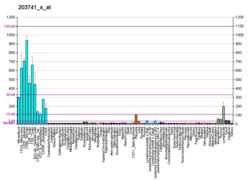ADCY7
Adenylyl cyclase type 7 is an enzyme that in humans is encoded by the ADCY7 gene.[5][6]
Function
This gene encodes a membrane-bound adenylyl cyclase that catalyses the formation of cyclic AMP from ATP and is inhibitable by calcium. The product of this gene is a member of the adenylyl cyclase class-4/guanylyl cyclase enzyme family that is characterized by the presence of twelve membrane-spanning domains in its sequences.[6]
References
- 1 2 3 GRCh38: Ensembl release 89: ENSG00000121281 - Ensembl, May 2017
- 1 2 3 GRCm38: Ensembl release 89: ENSMUSG00000031659 - Ensembl, May 2017
- ↑ "Human PubMed Reference:".
- ↑ "Mouse PubMed Reference:".
- ↑ Hellevuo K, Berry R, Sikela JM, Tabakoff B (Mar 1995). "Localization of the gene for a novel human adenylyl cyclase (ADCY7) to chromosome 16". Hum Genet. 95 (2): 197–200. doi:10.1007/bf00209401. PMID 7860067.
- 1 2 "Entrez Gene: ADCY7 adenylate cyclase 7".
External links
- Human ADCY7 genome location and ADCY7 gene details page in the UCSC Genome Browser.
Further reading
- Nomura N, Miyajima N, Sazuka T, et al. (1995). "Prediction of the coding sequences of unidentified human genes. I. The coding sequences of 40 new genes (KIAA0001-KIAA0040) deduced by analysis of randomly sampled cDNA clones from human immature myeloid cell line KG-1". DNA Res. 1 (1): 27–35. doi:10.1093/dnares/1.1.27. PMID 7584026.
- Nomura N, Miyajima N, Sazuka T, et al. (1995). "Prediction of the coding sequences of unidentified human genes. I. The coding sequences of 40 new genes (KIAA0001-KIAA0040) deduced by analysis of randomly sampled cDNA clones from human immature myeloid cell line KG-1 (supplement)". DNA Res. 1 (1): 47–56. doi:10.1093/dnares/1.1.47. PMID 7584028.
- Hellevuo K, Welborn R, Menninger JA, Tabakoff B (1997). "Human adenylyl cyclase type 7 contains polymorphic repeats in the 3' untranslated region: investigations of association with alcoholism". Am. J. Med. Genet. 74 (1): 95–8. doi:10.1002/(SICI)1096-8628(19970221)74:1<95::AID-AJMG19>3.0.CO;2-M. PMID 9034014.
- Barcova M, Speth C, Kacani L, et al. (1999). "Involvement of adenylate cyclase and p70(S6)-kinase activation in IL-10 up-regulation in human monocytes by gp41 envelope protein of human immunodeficiency virus type 1". Pflügers Arch. 437 (4): 538–46. doi:10.1007/s004240050815. PMID 10089566.
- Speth C, Joebstl B, Barcova M, Dierich MP (2000). "HIV-1 envelope protein gp41 modulates expression of interleukin-10 and chemokine receptors on monocytes, astrocytes and neurones". AIDS. 14 (6): 629–36. doi:10.1097/00002030-200004140-00001. PMID 10807185.
- Patke CL, Shearer WT (2000). "gp120- and TNF-alpha-induced modulation of human B cell function: proliferation, cyclic AMP generation, Ig production, and B-cell receptor expression". J. Allergy Clin. Immunol. 105 (5): 975–82. doi:10.1067/mai.2000.105315. PMID 10808179.
- Patrizio M, Colucci M, Levi G (2001). "Human immunodeficiency virus type 1 Tat protein decreases cyclic AMP synthesis in rat microglia cultures". J. Neurochem. 77 (2): 399–407. doi:10.1046/j.1471-4159.2001.00249.x. PMID 11299302.
- Yan SZ, Tang WJ (2002). "Construction of soluble adenylyl cyclase from human membrane-bound type 7 adenylyl cyclase". Meth. Enzymol. Methods in Enzymology. 345: 231–41. doi:10.1016/S0076-6879(02)45019-7. ISBN 978-0-12-182246-0. PMID 11665607.
- Speth C, Schabetsberger T, Mohsenipour I, et al. (2002). "Mechanism of Human Immunodeficiency Virus-Induced Complement Expression in Astrocytes and Neurons". J. Virol. 76 (7): 3179–88. doi:10.1128/JVI.76.7.3179-3188.2002. PMC 136041. PMID 11884542.
- Nelson EJ, Hellevuo K, Yoshimura M, Tabakoff B (2003). "Ethanol-induced phosphorylation and potentiation of the activity of type 7 adenylyl cyclase. Involvement of protein kinase C delta". J. Biol. Chem. 278 (7): 4552–60. doi:10.1074/jbc.M210386200. PMID 12454008.
- Strausberg RL, Feingold EA, Grouse LH, et al. (2003). "Generation and initial analysis of more than 15,000 full-length human and mouse cDNA sequences". Proc. Natl. Acad. Sci. U.S.A. 99 (26): 16899–903. doi:10.1073/pnas.242603899. PMC 139241. PMID 12477932.
- Ludwig MG, Seuwen K (2003). "Characterization of the human adenylyl cyclase gene family: cDNA, gene structure, and tissue distribution of the nine isoforms". J. Recept. Signal Transduct. Res. 22 (1–4): 79–110. doi:10.1081/RRS-120014589. PMID 12503609.
- Ota T, Suzuki Y, Nishikawa T, et al. (2004). "Complete sequencing and characterization of 21,243 full-length human cDNAs". Nat. Genet. 36 (1): 40–5. doi:10.1038/ng1285. PMID 14702039.
- Gerhard DS, Wagner L, Feingold EA, et al. (2004). "The Status, Quality, and Expansion of the NIH Full-Length cDNA Project: The Mammalian Gene Collection (MGC)". Genome Res. 14 (10B): 2121–7. doi:10.1101/gr.2596504. PMC 528928. PMID 15489334.
- Beeler JA, Yan SZ, Bykov S, et al. (2005). "A soluble C1b protein and its regulation of soluble type 7 adenylyl cyclase". Biochemistry. 43 (49): 15463–71. doi:10.1021/bi049088+. PMID 15581358.
- Kimura K, Wakamatsu A, Suzuki Y, et al. (2006). "Diversification of transcriptional modulation: Large-scale identification and characterization of putative alternative promoters of human genes". Genome Res. 16 (1): 55–65. doi:10.1101/gr.4039406. PMC 1356129. PMID 16344560.
- Hines LM, Hoffman PL, Bhave S, et al. (2006). "A sex-specific role of type VII adenylyl cyclase in depression". J. Neurosci. 26 (48): 12609–19. doi:10.1523/JNEUROSCI.1040-06.2006. PMID 17135423.
This article is issued from
Wikipedia.
The text is licensed under Creative Commons - Attribution - Sharealike.
Additional terms may apply for the media files.




